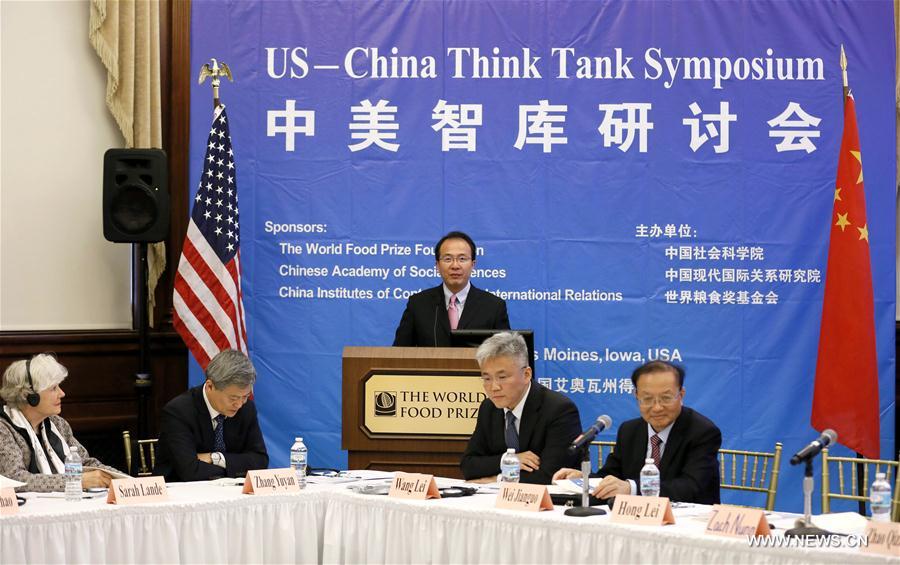
Chinese Consul General in Chicago Hong Lei (C, Rear) addresses the U.S.-China Think Tank Symposium in Des Moines, Iowa, the United States, on June 12, 2017. The prospects of U.S.-China relations are very promising, according to participants of the U.S.-China Think Tank Symposium, which opened Monday in Des Moines, capital of U.S. state of Iowa. (Xinhua/Wang Ping)
DES MOINES, the United States, June 12 (Xinhua) -- It sounds too abstract to say economic and trade cooperation is the most dynamic and lasting driving force for China-U.S. relations, one of the world's most important bilateral ties.
However, Hong Lei, China's Consul General to Chicago, drove his point home by going through intricate, important figures about the bilateral trade relations in a keynote speech at the U.S.-China Think Tank Symposium luncheon held in Des Moines, Iowa, Monday.
GOODS TRADE
Statistics show China-U.S. trade volume has grown from 2.5 billion U.S. dollars in 1979 to 524.3 billion dollars in 2016, a rise of 209 times, according to Hong.
China is the United States' largest export market outside North America, and is also one of the fastest growing major export markets of the United States.
In the past 10 years, the average annual growth rate of U.S. exports to China hit 11 percent, higher than not only the 4 percent of average growth rate of U.S. total exports during the same period, but also the 6.6 percent of average growth rate of China's exports to the United States in this period, said the Chinese diplomat.
Since China's accession to the WTO, U.S. exports to China in 2016 has been up 500 percent from 2001, while U.S. global exports during the same period only grew by 90 percent. China has become an important overseas market of many products of the United States, especially bulk agricultural products and high-end finished products.
Hong said in 2016, the United States exported 440 aircraft to China worth of 12.5 billion dollars; 33.66 million tons of soybeans worth of 13.8 billion dollars, many of which are from the state of Iowa; 255,000 automobiles worth of 12.1 billion dollars; 9.7 billion dollars of integrated circuits; and 260,000 tons of cotton worth of 500 million dollars.
Currently, China is the largest export market of American aircraft and soybeans, and the second largest market of American automobiles, integrated circuits and cotton. Among U.S. exports, 62 percent of soybeans, 17 percent of automobiles, 15 percent of integrated circuits, 14 percent of cotton and some 25 percent of Boeing aircraft are sold to China, he said.
SERVICE TRADE
From 2006 to 2016, the service exports of the United States to China expanded from 14.4 billion dollars to 86.9 billion dollars, a rise of 5 times, Hong said.
In 2016, the U.S. trade surplus with China in services reached 55.7 billion dollars, 40 times the amount of 2006.
As for tourism, according to the Chinese Ministry of Commerce, Chinese tourists spent some 13,000 dollars in the U.S. per person in 2016, far more than the tourists from other countries. In 2016, Chinese tourists spent a total of 35.22 billion dollars in the U.S., creating about 97 million dollars of revenue for the U.S. per day.
EDUCATION
The United States is Chinese students' top destination for studying abroad. According to a report published by U.S. Immigration and Customs Enforcement in May 2016, there were some 353,000 Chinese students studying in the U.S., accounting for 34 percent of the total number of international students in the U.S., said Hong.
According to the estimates of the Chinese Ministry of Commerce, Chinese students studying in the U.S. spent about 45,000 dollars per person in 2016, contributing around 15.9 billion dollars of revenue to the U.S., he said.
In 2016, the U.S. exported to China 51 movies, obtaining revenue of 16 billion dollars, four times of other countries' movie exports to China combined.
INVESTMENT
U.S.-invested enterprises in China have maintained good performance and gained high profits. Sales revenue in 2015 totaled 517 billion dollars, and profit reached 36.2 billion dollars, Hong said.
In 2016, the total revenue of U.S.-funded banks, insurance and security companies was 48 billion dollars; and the total revenue of U.S.-funded accounting firms, law firms and consulting firms exceeded 19 billion dollars, he said.
In 2016, General Motors sold 3.87 million automobiles in China at a rate of one automobile per 8 seconds. Ford Motor sold 1.27 million automobiles at a rate of one automobile per 25 seconds. Both enterprises set new records in sales volumes in China. Through over 2,200 stores in China, McDonald's sells 1,600 hamburgers every minute.
At the meantime, Chinese investment in the U.S. is growing rapidly. According to a report published by the National Committee on United States-China Relations and Rhodium Group, in 2016, Chinese enterprises invested 45.6 billion dollars in the U.S., a 200 percent increase from the previous record set in 2015.
By the end of 2016, the accumulative total of Chinese foreign direct investment in the U.S. reached around 109 billion dollars, covering such sectors as services, manufacturing, real estate, hospitality, information and communication technology, entertainment and financial services.
Nearly 98 percent (425 of 435) of congressional districts in 46 states hosted Chinese-owned establishments. The total number of Americans employed by Chinese-owned companies exceeded 141,000, and most of them work in the manufacturing sector, Hong said.















